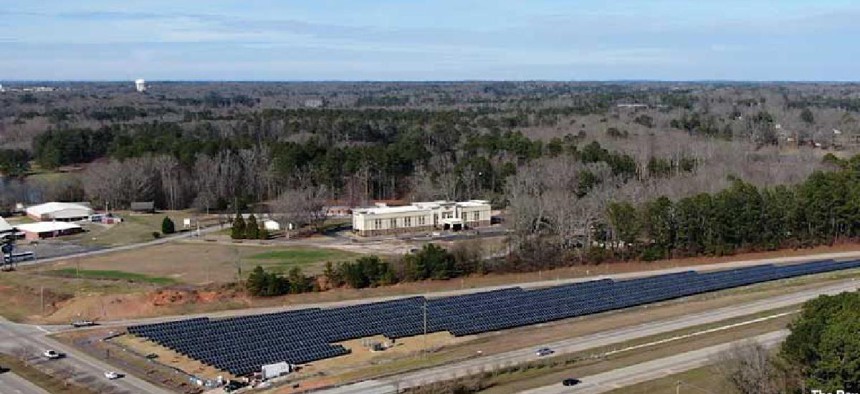Sustainable highway projects support connected vehicle infrastructure


Connecting state and local government leaders
The Ray, a Georgia-based living lab for transportation innovation, has partnered with agencies in Georgia and Central Texas on sustainability and connected and autonomous vehicle infrastructure.
The Ray, a Georgia-based living lab for transportation innovation, is working with 3M and Panasonic to collect data from roadways.
With 3M, The Ray is creating and installing smart road dots, or sensing reflectors, while Panasonic builds a cloud-based data platform to manage and analyze the information.
The effort, which The Ray announced in February, is an expansion of work it has already done with 3M. In December 2019, the organization worked with the Georgia Department of Transportation to restripe all lanes on 13 miles of I-85 with Connected Roads All Weather Elements optic technology, providing visibility during the day or night and in wet weather conditions. The stripes use refractive index-based technology that supports autonomous vehicles with machine vision systems.
“We have patents, we have protected intellectual property for road dots – road sensors – that are solar-powered and give the road some self-awareness by collecting data from the road surface,” The Ray Executive Director Allie Kelly said. The Ray uses an 18-mile stretch of I-85 in southwest Georgia.
Right now, road dots in general aren’t connected, but they are rugged. They rarely break or damage tires, making them a potential source of real-time, real-place, validated road information.
That way, it’s not just vehicles broadcasting data, Kelly said, adding, “We want to enable the roads to join into the conversation as well.”
Panasonic’s digital data management platform would analyze the inputs and datasets collected by smart infrastructure such as the dots, and because it’s in the cloud, law enforcement, first responders and traffic safety officials could easily access it.
“We believe that there’s an opportunity for these road dots that have sensors that are solar-powered to be connected into these data management platforms so that we could be managing data as well, not only from connected cars but also the road surface to give us higher fidelity of information and a higher-fidelity picture of what is going on,” Kelly said.
These types of “twofers,” as Kelly calls them, are part of The Ray’s mission to reduce waste and increase productivity. “This is particularly true in the transportation sector, where we really do have so much infrastructure and assets that could be multitasking,” she said.
The organization has recently partnered with agencies in Central Texas on sustainability and connected and autonomous vehicle infrastructure.
The Ray announced a partnership with the Texas Department of Transportation (DOT) Austin District, Central Texas Regional Mobility Authority and the city of Austin in late March, after months of discussion about projects that would pilot new technologies.
One project involves bringing one of The Ray’s sustainability initiatives to Central Texas. In Georgia, the nonprofit organization built a large solar site on the roadside of the Interstate 85’s Exit 14 – a traditional diamond-shaped interchange, with four triangular quadrants at the exit and access lanes.
“We’ve used one-quarter of that interchange – one of those grassy diamond areas that was completely empty and cleared of trees – and through an innovative partnership with Georgia Power and Georgia DOT, we have utilized that DOT property for 2,600 solar panels generating a megawatt of clean energy,” Kelly said.
Another renewable-energy strategy for Central Texas creates shade from transportation assets in the city and along the corridors that the mobility authority and Texas DOT operate, Kelly said.
“In a region like the Southwest, where your summer temperatures commonly exceed 100 degrees, shade is a public safety and a human life safety issue, and it’s also an equity issue,” she said. “Particularly [for] people who are heavy users of public transit, shade can be a serious issue during the summer and fall months. This infrastructure can do double duty. It can be utilizing solar canopies, solar bus shelters and solar trees to not only generate clean, carbon-free energy for the Austin area, but we can also create some additional shade for the citizens.”
Austin, which is home to smart technology companies including Tesla, Dell and Apple, is also looking to work with The Ray on infrastructure for autonomous and connected vehicles, but the details of those projects are still in the works, Kelly said, adding that announcements related to the partnership will come out throughout 2021.
The Ray’s charter with the city and letters of understanding with Texas DOT and the mobility authority list no end date for the projects.
The Ray has partnered with 20 agencies in 14 states so far, and will announce later this month work with two more states, Kelly said. He declined to provide additional details before the official announcements come out.
The Ray is named after Ray Anderson, a Georgia businessman who challenged his company, Interface, to pursue a zero environmental footprint.




